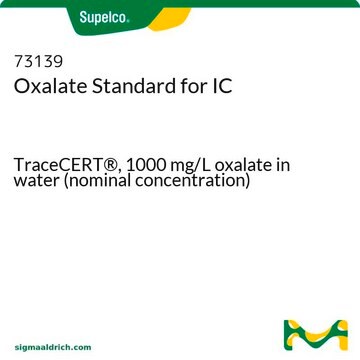71800
Sodium oxalate
puriss. p.a., ACS reagent, ≥99.5% (RT)
Synonym(s):
Ethanedioic acid sodium salt, Oxalic acid disodium salt
Select a Size
Select a Size
About This Item
Recommended Products
grade
ACS reagent
puriss. p.a.
Quality Level
assay
≥99.5% (RT)
form
powder or crystals
impurities
≤0.002% ammonium (NH4)
loss
≤0.01% loss on drying, 105 °C
pH
7-8.5 (25 °C, 2.5% in H2O)
anion traces
chloride (Cl-): ≤20 mg/kg
sulfate (SO42-): ≤20 mg/kg
cation traces
Ca: ≤100 mg/kg
Cd: ≤10 mg/kg
Co: ≤5 mg/kg
Cr: ≤5 mg/kg
Cu: ≤5 mg/kg
Fe: ≤10 mg/kg
K: ≤50 mg/kg
Mg: ≤10 mg/kg
Mn: ≤50 mg/kg
Ni: ≤5 mg/kg
Pb: ≤5 mg/kg
Zn: ≤5 mg/kg
SMILES string
[Na+].[Na+].[O-]C(=O)C([O-])=O
Looking for similar products? Visit Product Comparison Guide
General description
Application
signalword
Warning
hcodes
Hazard Classifications
Acute Tox. 4 Dermal - Acute Tox. 4 Oral
Storage Class
11 - Combustible Solids
wgk_germany
WGK 1
flash_point_f
Not applicable
flash_point_c
Not applicable
Choose from one of the most recent versions:
Already Own This Product?
Find documentation for the products that you have recently purchased in the Document Library.
Customers Also Viewed
Our team of scientists has experience in all areas of research including Life Science, Material Science, Chemical Synthesis, Chromatography, Analytical and many others.
Contact Technical Service










